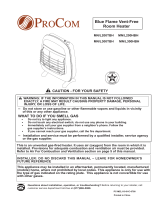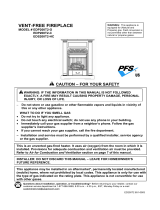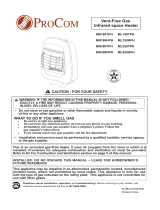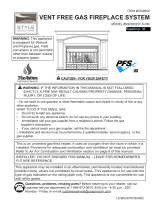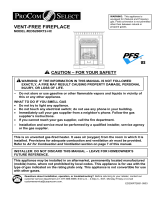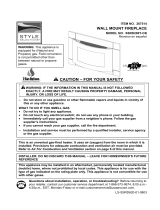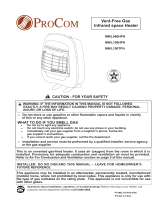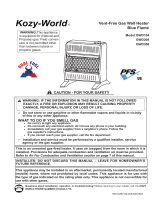Page is loading ...

WALL MOUNT FIREPLACE
MODEL #RD-S
RD-C
CAUTION – FOR YOUR SAFETY
Questions about installation, operation, or troubleshooting? Before returning to your retailer,
call customer service department toll-free at (877)886-5989.
This is an unvented gas-fired heater. It uses air (oxygen) from the room in which it is
installed. Provisions for adequate combustion and ventilation air must be provided.
Refer to
Air
for
Combustion and Ventilation
section on page 5 of this manual.
This appliance may be installed in an aftermarket*, permanently located
manufactured (mobile) home, where not prohibited by local codes. This appliance is
only for use with the type of gas indicated on the rating plate. This appliance is not
convertible for
use with other gases.
– Do not store or use gasoline or other flammable vapors and liquids in vicinity of
this or any other appliance.
WHAT TO DO IF YOU SMELL GAS
· Do not try to light any appliance.
· Do not touch any electrical switch; do not use any phone in your building.
· Immediately call your gas supplier from a neighbor’s phone. Follow the gas
supplier’s instructions.
· If you cannot reach your gas supplier, call the fire department.
– Installation and service must be performed by a qualified installer, service
agency or the gas supplier.
INSTALLER: DO NOT DISCARD THIS MANUAL – LEAVE FOR HOMEOWNER’S
FUTURE REFERENCE.
WARNING: IF THE INFORMATION IN THIS MANUAL IS NOT FOLLOWED
EXACTLY, A FIRE MAY RESULT CAUSING PROPERTY DAMAGE, PERSONAL
INJURY, OR LOSS OF LIFE.
WARNING: This appliance is equipped
for (Natural and Propane) gas. Field
conversion is not permitted other than
between natural or propane gases.
HS
-
RD
622
-
0707

2
TABLE OF CONTENTS
Important Safety Information...........................................................................................................................................3
Air for Combustion and Ventilation..................................................................................................................................5
Installation.......................................................................................................................................................................7
Operating.......................................................................................................................................................................13
Cleaning & Maintenance...............................................................................................................................................15
Troubleshooting.............................................................................................................................................................15
Replacement Parts........................................................................................................................................................18
WARNING: READ THE INSTALLATION & OPERATION INSTRUCTIONS
BEFORE USING THIS APPLIANCE
IMPORTANT: Read instructions and warnings carefully before starting installation. Failure to follow these instructions
may result in a possible fire hazard and will void the warranty.
PRODUCT SPECIFICATIONS
MODEL# RD-S & RD-C
Input Rating 20000 BTU/Hr 20000 BTU/Hr
Gas Type Natural LP/Propane
Ignition Electronic Piezo Electronic Piezo
Manifold Pressure 4 in. W.C. 9 in. W.C.
Inlet Gas Pressure
Maximum 10.5 in. 14 in.
Minimum 5 in. 11 in.
Dimensions, inches (H x W x D)
Heater 26.75 in. x 38.25 in. x 12.25 in.
Carton 25 in. x 34.65 in. x 15.75 in.
Weight, lbs
Stove 53
Shipping 60
*For purposes of input adjustment

3
IMPORTANT SAFETY INFORMATION
IMPORTANT: Read this owner’s manual carefully and completely before trying to assemble, operate, or service this
heater. Improper use of this heater can cause serious injury or death from burns, fire, explosion, electrical shock, and
carbon monoxide poisoning.
Installation and service must be performed by a qualified installer, service agency, or local gas supplier.
WARNING: Do not store or use gasoline or other flammable vapors or liquids in the vicinity of this or any other
appliance.
CARBON MONOXIDE POISONING: Early signs of carbon monoxide poisoning resemble the flue with
headaches, dizziness, or nausea. If you have these signs, the heater may not be working properly. Get fresh air
immediately! Have heater services. Some people are more affected by carbon monoxide than others. These include
pregnant women, people with heart, or lung disease, anemia, those under the influence of alcohol, and those at high
altitudes.
NATURAL AND PROPANE/LP GAS: Natural and Propane/LP gases are odorless. An odor-making agent is
added to the gas. The odor helps you detect a gas leak. However, the odor added to the gas can fade. Gas may be
present even though no odor exists. Make certain you read and understand all warnings Keep this manual for reference. It
is your guide to safe and proper operation of this heater. Make certain you read and understand all warnings. Keep this
manual for reference. It is your guide to safe and proper operation of this heater.
WARNING: Any change to this fireplace or its controls can be dangerous.
WARNING: Do not allow fans or any other drafts that alter burner flame to blow directly into the heater. They
create drafts that alter burner flame patterns, which can cause sooting.
WARNING: Do not use a blower insert, heat exchange insert, or other accessory not approved for use with this
heater.
Due to high temperatures, the appliance should be located out of traffic and away from furniture and draperies. Do not
place clothing or other flammable material on or near the appliance. Never place any objects in the fireplace. Heater
becomes very hot when running fireplace. Keep children and adults away from hot surfaces to avoid burns or clothing
ignition. Fireplace will remain hot for a time after shutdown. Allow surfaces to cool before touching. Carefully supervise
young children when they are in the room with the fireplace.
You must operate this heater with the heater glass panel in place. Keep the appliance area clear and free from
combustible materials, gasoline, and other flammable vapors and liquids.
1. Do not place Propane/LP supply tank(s) inside any structure. Place Propane/LP supply tank(s) outdoors.
2. This heater shall not be installed in a bedroom or bathroom.
3. This heater is designed to be smokeless. Note: During initial operation, slight smoking could occur due to heater
burning manufacturing residues.
4. To prevent the creation of soot, follow the instructions in Cleaning and Maintenance (page 15).
5. Before using furniture polish, wax, carpet cleaner, or similar products, turn heater off. If heated, the vapors from these
products may create a white powder residue within burner box or on adjacent walls or furniture.

4
6. This heater needs fresh air ventilation to run properly. This heater has an Oxygen Depletion Sensing (ODS) safety
shutoff system. The ODS shuts down the heater if not enough fresh air is available. See Air for Combustion and
Ventilation, pages 5 through 7. If heater keeps shutting off, see Troubleshooting, pages 15 through 17.
7. Do not run heater:
· Where flammable liquids or vapors are used or stored.
· Under dusty conditions.
8. Do not use this heater to cook food or burn paper or other objects.
9. Do not use this heater if any part has been under water. Immediately call a qualified service technician to inspect the
heater and replace any part of the control system and any gas control which has been under water.
10. Turn off heater and let cool before servicing. Only a qualified service person should service and repair heater.
11. Operating heater above elevations of 4,500 feet could cause pilot outage.
12. To prevent performance problems, do not use propane/LP fuel tank of less than 100 lbs. capacity.
QUALIFIED INSTALLING AGENCY
Installation and replacement of gas piping, gas utilization equipment or accessories and repair and servicing of equipment
shall be performed only by a qualified agency. The term “qualified agency” means any individual, firm, corporation, or
company that either in person or through a representative is engaged in and is responsible for:
a) The installation, testing, or replacements of gas piping or
b) The connection, installation, testing, repair, or servicing of equipment; that is experienced in such work; that is
familiar with all precautions required; and that has complied with all the requirement of the authority having
jurisdiction.
PRODUCT FEATURES
SAFETY PILOT
This heater has a pilot with an Oxygen Depletion Sensing (ODS) safety shutoff system.
The ODS/pilot is a required feature for vent-free room heaters. The ODS/pilot shuts off
the heater if there is not enough fresh air.
DUAL FUEL CAPABLE
Your Fireplace is equipped to operate on either Propane or Natural gas. The fireplace is
shipped from the factory ready for connecting to Propane. The fireplace can easily be
changed to Natural gas by having your qualified installer follow the instructions on page
9 & 10 and the markings on the fireplace.
LOCAL CODES
Install and use heater with care. Follow all codes. In the absence of local codes, use the
latest edition of The National Fuel Gas Code, ANSI Z223.1, also known as NFPA 54*.
*Available from:
American National Standards lnstitute, lnc.
1430 Broadway
New York, NY 10018
National Fire Protection Association, lnc.
1 Batterymarch Park
Quincy, MA 02269
This heater is designed for vent-free operation. State and local codes in some areas prohibit the use of vent-free heaters.
State of Massachusetts: The
installation must be made by
a licensed plumber or gas
fitter in the Commonwealth of
Massachusetts. Sellers of
unvented propane or natural
gas-fired supplemental room
heaters shall provide to each
purchaser a copy of 527 CMR
30 upon sale of the unit.
In the State of Massachusetts,
unvented propane or natural
gas-fired space heaters shall
be prohibited in bedrooms
and bathrooms.
In the State of
Massachusetts the gas
cock must be a T-handle
type. The State of
Massachusetts requires
that a flexible appliance
connector cannot
exceed three feet in
length.

5
UNPACKING
1. Remove top inner pack
2. Tilt carton so that fireplace is upright.
3. Remove protective side packaging.
4. Slide fireplace out of carton.
5. Remove protective plastic wrap.
6. Check for any shipping damage. If fireplace is damaged, promptly inform dealer where you bought fireplace.
WATER VAPOR: A BY-PRODUCT OF UNVENTED ROOM HEATERS
Water vapor is a by-product of gas combustion. An unvented room heater produces approximately one (1) ounce (30ml)
of water for every 1,000 BTUs (.3kWs) of gas input per hour. An unvented room heater is recommended as a
supplemental heater (a room) rather than a primary heat source (an entire house). In most supplemental heat applications,
the water vapor does not create a problem. In most applications, the water vapor enhances the low humidity atmosphere
experienced during cold weather. The following steps will help insure that water vapor does not become a problem:
1. Be sure the heater is the proper size for the application, including adequate combustion air and circulation air.
2. If high humidity is experienced, the dehumidifier may be used to help lower the water vapor content of the air.
3. Do not use an unvented room heater as the primary heat source.
AIR FOR COMBUSTION AND VENTILATION
WARNING: This heater shall not be installed in a confined space or unusually tight construction unless provisions
are provided for adequate combustion and ventilation air. Read the following instructions to insure proper fresh air
for this and other fuel-burning appliances in your home.
PRODUCING ADEQUATE VENTILATION
The following are excerpts from National Fuel Gas Code, NFPA 54/ANSI Z223.1,Section 5.3, Air for Combustion and
Ventilation. All spaces in homes fall into one of the three following ventilation classifications:
1. Unusually Tight Construction
2. Unconfined Space
3. Confined Space
The information on pages 6 through 8 will help you classify your space and provide adequate ventilation.
Confined and Unconfined Space
The National Fuel Gas Code, ANS Z223.1 defines a confined space as a space whose volume is less than 50 cubic feet
per 1,000 Btu per hour (4.8 m^3 per kw) of the aggregate input rating of all appliances installed in that space and an
unconfining space as a space whose volume is not less than 50 cubic feet per 1,000 Btu per hour (4.8 m^3 per kw) of the
aggregate input rating of all appliances installed in that space. Rooms communicating directly with the space in which the
appliances are installed*, through openings not furnished with doors, are considered a part of the unconfined space.
This heater shall not be installed in a confined space or unusually tight construction unless provisions are provided for
adequate combustion and ventilation air.
· Adjoining rooms are connecting only if there are doorless passageways or ventilation grills between them
Unusually Tight Construction
The air that leaks around doors and windows may provide enough fresh air for combustion and ventilation. However, in
buildings of unusually tight construction, you must provide additional fresh air.

6
Unusually tight construction is defined as construction where:
a) walls and ceilings exposed to the outside atmosphere have a continuous water vapor retarder with a rating of one perm
(6x10
-11
kg per pa-sec-m
2
) or less with openings gasketed or sealed and
b) weather stripping has been added on windows that can be opened and doors and
c) caulking or sealants are applied to areas such as joints around window and door frames, between sole plates and
floors, between wall-ceiling joints, between wall panels, at penetrations for plumbing, electrical, and gas lines, and at other
openings.
If your home meets all of the three criteria above, you must provide additional fresh air. See “Ventilation Air From
Outdoors” (page 7). If your home does not meet all of the three criteria above, proceed to “Determining Fresh-Air Flow For
Heater Location: (next page).
DETERMINING FRESH-AIR FLOW FOR HEATER LOCATION
Determining if You Have a Confined or Unconfined Space
Use this worksheet to determine if you have a confined or unconfined space.
Space: Includes the room in which you will install heater plus any adjoining rooms with doorless passageways or
ventilation grills between the rooms.
1. Determine the volume of the space Length×Width×Height= ________ cu.ft. (volume of space)
Example: Space size 20ft. (length)×16ft.(width)×8ft. (ceiling height)=2560cu. ft. (volume of space)
If additional ventilation to adjoining room is supplied with grills or openings, add the volume of these rooms to the
total volume of the space.
2. Divide the space volume by 50 cubic feet to determine the maximum Btu/Hr the space can support.
__________(volume of space)÷50 cu. ft.=(Maximum Btu/Hr the space can support)
Example: 2560 cu. ft. (volume of space)?0 cu.ft.=51.2 or 51,200 (maximum Btu/Hr the space can support)
3. Add the Btu/Hr of all fuel burning appliances in the space.
Vent-free heater ______________Btu/Hr
Gas water heater* ______________Btu/Hr
Gas furnace ______________Btu/Hr
Vented gas heater ______________Btu/Hr
Gas heater logs ______________Btu/Hr
Other gas appliances*+ ______________Btu/Hr
Total =______________Btu/Hr
*Do not include direct-vent gas appliances. Direct-vent draws combustion air from the outdoors and vents to the outdoors.
4. Compare the maximum Btu/Hr the space can support with the actual amount of Btu/Hr used.
Btu/Hr (maximum the space can support)
Btu/Hr (actual amount of Btu/Hr used).
Example : 51,200 Btu/Hr(maximum the space can support)
56,000 Btu/Hr(actual amount of Btu/Hr used)
The space in the above example is a confined space because the actual Btu/Hr used is more than the maximum Btu/Hr
the space can support. You must provide additional fresh air. Your options are as follows:
a) Rework worksheet, adding the space of an adjoining room. If the extra space provides an unconfined space,
remove door to adjoining room or add ventilation grills between rooms. See “Ventilation Air From Outdoors,”
page 7.
b) Vent room directly to the outdoors. See “Ventilation Air From Outdoors”, 7.
c) Install a lower Btu/Hr heater if lower Btu/Hr size makes room unconfined. If the actual Btu/Hr used is less than
the maximum Btu/Hr the space can support, the space is an unconfined space. You will need no
additional fresh air ventilation.
WARNING: If the area in which the heater may be operated is smaller than that defined as an unconfined space or if the
building is of unusually tight construction, provide adequate combustion and ventilation air by one of the methods
described in the National Fuel Gas Code, ANSI Z223.1/NFPA 54, Air for Combustion and Ventilation, or applicable local
codes.
Example:
Gas water heater 30,000 Btu/Hr
Vent-free heater + 26,000 Btu/Hr
Total = 56,000 Btu/Hr

7
Ventilation Air From Inside Building
This fresh air would come from adjoining unconfined space. When ventilating
to an adjoining unconfined space, you must provide two permanent openings:
one within 12 inches of the wall connecting the two spaces (see options 1 and
2, Figure 1). You can also remove door into adjoining room (see option 3,
Figure 1). Follow the National Fuel Gas Code NFPA 54/ANSI Z223.1. Section
5.3, “Air for Combustion and Ventilation” for required size of ventilation grills
or ducts.
Ventilation Air From Outdoors
Provide extra fresh air by using ventilation grills or duct. You must provide two
permanent openings: one within 12 inches of the ceiling and one within 12
inches of the floor. Connect these items directly to the outdoors or spaces
open to the outdoors (see Figure 2). These spaces include attics and crawl
spaces. Follow the National Fuel Gas Code NFPA 54/ANSI Z223.1, Section
5.3. Air for Combustion and Ventilation for required size of ventilation grills or
ducts.
IMPORTANT: Do not provide openings for inlet or outlet air into
attic if attic has a thermostat-controlled power vent. Heated air
entering the attic will activate the power vent. Rework worksheet,
adding the space of the adjoining unconfined space. The combined
spaces must have enough fresh air to supply all appliances in both
spaces.
INSTALLATION
NOTICE: This heater is intended for use as supplemental heat.
Use this heater along with your primary heating system. Do not install this
heater as your primary heat source. If you have a central heating system,
you may run system’s circulating blower while using heater. This will help
circulate the heat throughout the house.
WARNING: A qualified technician must install heater. Follow all local codes.
WARNING: Never install the heater
· in a bedroom or bathroom
· in a recreational vehicle
· flammable objects are less than 42 inches from the front, top, or sides of the heater
· in high traffic areas
· in windy or drafty areas
CAUTION: This heater creates warm air currents. These currents move heat to wall surfaces next to heater.
Installing heater next to vinyl or cloth wall coverings or operating heater where impurities (such as tobacco smoke,
aromatic candles, cleaning fluids, oil or kerosene lamps, etc.) in the air exist, may discolor walls.
WARNING: Maintain the minimum clearances. If you can, provide greater clearances from floor, ceiling and
adjoining side and back walls.
IMPORTANT: Vent-free heaters add moisture to the air. Although this is beneficial, installing heater in rooms without
enough ventilation air may cause mildew to form from too much moisture. See Air for Combustion and Ventilation, pages
5 through 7.
CHECK GAS TYPE
Use only the type of gas indicated on the plate. If your gas supply can not meet that requirement, do not install heater.
Call the dealer where you purchased heater for the proper type of heater.
Figure 1 - Ventilation Air from Inside
Building
Figure 2 - Ventilation Air from Outdoors

8
CLEARANCES TO COMBUSTIBLES
Carefully follow the instructions below. This fireplace is a wall
mount unit designed to mount directly on a wall.
IMPORTANT: You must maintain minimum wall and ceiling
clearances during installation. The minimum clearances are
shown in Figure 3. Measure from outermost point of fireplace.
Minimum Wall and Ceiling Clearances (see Figure 3)
A. Clearances from outermost point of fireplace to any
combustible side wall should not be less than 4 inches
from the left side and 18 inches from the right side.
B. Clearances from the fireplace to the ceiling should not
be less than 24 inches.
C. Clearance from bottom of fireplace to the floor should
not be less than 4 inches.
CONNECTING TO GAS SUPPLY
WARNING: A qualified technician must connect heater
WARNING: This appliance requires a 3/8” NPT inlet
connection to pressure regulator (see figure 4).
CAUTION: Never connect heater directly to the gas supply.
This heater requires an external regulator (not supplied). The
external regulator between the gas supply and heater must be installed.
INSTALLATION ITEMS NEEDED
Before installing heater, make sure you have the items listed below.
· piping (check local codes)
· sealant (resistant to propane/LP gas)
· equipment shutoff valve*
· test gauge connection**
· sediment trap
· tee joint
· pipe wrench
· Flexible Gas hose (check local code)
* A CSA design-certified equipment shutoff valve with 1/8” NPT tap is an
acceptable alternative to test gauge connection. Purchase the optional
CSA design-certified equipment shutoff valve from your dealer.
WARNING: Never connect heater to private (non-utility) gas
wells. This gas is commonly known as wellhead gas. The installer
must supply an external regulator. The external regulator will reduce
incoming gas pressure. You must reduce incoming gas pressure to
between 11 and 14 inches of water column for propane and between
5 and 10.5 inches of water column for natural gas. If you do not
reduce incoming gas pressure, heater regulator damage could occur.
lnstall external regulator with the vent pointing down as shown in
Figure 5. Pointing the vent down protects it from freezing rain or sleet.
Figure 3 - Minimum Clearance to Wall and
Ceiling
Figure 4 – Gas Regulator Location and
Gas Line Access Into Fireplace Cabinet
Figure 5 – External Regulator With
Vent Pointing Down

9
INSTALLATION
Continued
CAUTION: Use only new black iron or steel pipe.
Internally tinned copper tubing may be used in certain areas.
Check your local codes. Use pipe of ½ inch diameter or greater to
allow proper volume gas to heater. If pipe is too small, loss of
pressure will occur. Installation must include an equipment shutoff
valve, union, and plugged 1/8-inch NPT tap. Locate NPT tap
within reach for test gauge hook up. NPT tap must be upstream
from heater (see Figure 6).
*Purchase the optional CSA design-certified equipment shut off valve
from your dealer. See Accessories
**Minimum inlet pressure for purpose of input adjustment.
IMPORTANT: Install equipment shutoff valve in an accessible location. The equipment shutoff valve is for turning on
or shutting off the gas to the appliance. Apply pipe joint sealant lightly to male threads. This will prevent excess sealant
from going into pipe. Excess sealant in pipe could result in clogged heater valves.
CAUTION: Use pipe joint sealant that is resistant to gas (PROPANE or NG). We recommend that you install a
sediment trap in a supply line as shown in Figure 6. Locate sediment trap where it is within reach for cleaning. Install in
the piping system between fuel supply and heater. Locate sediment trap where trapped matter is not likely to freeze. A
sediment trap traps moisture and contaminants. This keeps them from going into heater controls. If sediment trap is not
installed or is installed incorrectly, heater may not run properly.
CAUTION: Avoid damage to regulator. Hold gas regulator with wrench when connecting into gas piping and/or
fittings. NG Models: 5 in. to 10.5 in. W.C. Gas supplier provide external regulator for natural gas
CAUTION: Two gas line installation at the same time is forbidden. You are not allowed to open the cover while
the machine is running.
Heater is pre-set at factory for propane gas, no changes are required for connecting to propane. Only a qualified installer
or service technician can perform gas selection and connecting to gas supply.
CAUTION: To avoid gas leakage at the inlet of regulator, a qualified installer or service technician must use hex plug
with sealant.
For changing from propane to natural gas supply:
1. Remove top screw from cover plate, See Figure 7, and rotate to expose gas selection valve.
2. For NATURAL GAS, press knob using a flat screw driver with a blade with thickness of a quarter and turn knob
clockwise until the knob locks into the NG position (see Figure 8). Selection valve must be locked in the NG
position. Do not operate heater between locked positions!
3. Rotate and close cover over gas selection valve and reinstall screw.
4. Remove hex plug (with wrench provided) from natural gas inlet of regulator and install into LP inlet of
regulator; use thread sealant to assure there are no leaks.
For changing from natural gas supply to propane supply:
1. Remove top screw from cover plate, see Figure 7, and rotate to expose gas selection valve.
2. For propane gas, press in knob using a flat screw driver with a blade the thickness of a quarter and turn knob
counterclockwise until the knob locks into the LP position, see Figure 9. Selection valve must be locked in the
LP position. Do not operate heater between locked positions.
3. Rotate and close cover over gas selection valve and reinstall screw.
Figure 6 – Gas Connection

10
4. Remove hex plug from liquid propane inlet of regulator and install into NG inlet of regulator; use thread sealant to
assure there are no leaks.
CHECKING GAS CONNECTIONS
WARNING: Test all gas piping and connections for leaks after installing or servicing. Correct all leaks
immediately.
Pressure Testing Gas Supply Piping System Test
Pressures In Excess Of 1/2 PSIG (3.5kPa)
1. Disconnect heater with its appliance main gas valve (control valve) and equipment shutoff valve from gas supply
piping system. Pressures in excess of 1/2 psig will damage heater regulator.
2. Cap off open end of gas pipe where equipment shutoff valve was connected.
3. Pressurize supply piping system by either using compressed air or opening gas supply tank valve.
4. Check all joints of gas supply piping system. Apply mixture of liquid soap and water to gas joints. Bubbles forming
show a leak.
5. Correct al leaks immediately.
6. Reconnect heater and equipment shutoff valve to gas supply. Check reconnected fittings for leaks.
Figure 9
Figure 7
Figure 8

11
WARNING: Never use an open flame to check for a leak. Apply a mixture of liquid soap and water to all joints.
Bubbles forming show a leak. Correct all leaks immediately.
Pressure Testing Heater Gas Connections
1. Open equipment shutoff valve (see Figure 10).
2. Open gas supply tank valve.
3. Make sure control knob of heater is in the OFF position.
4. Check all joints from equipment shutoff valve to control valve
(Figure 11). Apply mixture of liquid soap and water to gas joints.
Bubbles forming show a leak
5. Correct all leaks immediately.
6. Light heater (see Operating, page 15).Check all other internal joints for leaks.
7. Turn off heater (see “To Turn Off Gas Appliance,” page 13).
CAUTION: Make sure external regulator has been installed between
gas supply and heater. See guidelines under “Connecting to Gas Supply”
(page 8).
Test Pressures Equal To or Less Than 1/2 PSIG (3.5 kPa)
1. Close equipment shutoff valve (see Figure 10).
2. Pressurize supply piping system by either using compressed air or
opening gas supply tank valve.
3. Check all joints from gas meter to equipment shutoff valve (see
Figure 11). Apply mixture of liquid soap and water to gas joints.
Bubbles forming show a leak.
4. Correct all leaks immediately.
FASTENING HEATER TO WALL
Mounting Bracket
The mounting bracket is located on back panel of heater (see Figure 12).
It has been taped there for shipping. Remove mounting bracket from
back panel.
Methods For Attaching Mounting Bracket To Wall
Use only the holes provided in mounting bracket to attach bracket to
wall. Attach mounting bracket to wall only in one of two ways:
1. To wall stud
2. To wall anchor
Attaching to Wall Stud: This method provides the strongest hold.
Insert mounting screws through mounting bracket and into wall
studs.
Attaching to Wall Anchor: This method allows you to attach
mounting bracket to hollow walls (wall areas between studs)
or to solid walls (concrete or masonry). Decide which method
better suits your needs. Either method will provide a secure
hold for the mounting bracket.
Figure 10
Figure 11
Figure 12 – Mounting Bracket Location

12
INSTALLATION
Continued
Marking Screw Locations:
1. Tape mounting bracket to wall where heater will be located. Make
sure mounting bracket is level.
WARNING: Maintain minimum clearances shown in Figure 13.
If you can, provide greater clearances from floor and joining wall.
2. Mark screw locations on wall (see Figure 13). If you can, provide
greater clearances from floor and joining wall.
Note: Mark only the last hole on each end of mounting bracket
insert mounting screws through these holes only.
3. Remove tape and mounting bracket from wall.
Attaching Mounting Bracket to Wall
Note: Wall anchors, mounting screws, and spacers are in the hardware
package. The hardware package is provided with heater. Attaching to Wall
Stud Method For attaching mounting bracket to wall studs:
1. Drill holes at marked locations using 9/64 -inch drill bit.
2. Place mounting bracket onto wall. Line up last hole on each end of
bracket with holes drilled in wall.
3. Insert mounting screws through bracket and into wall studs.
4. Tighten screws until mounting bracket is firmly fastened to wall studs.
Attaching to Wall Anchor Method
For attaching mounting bracket to hollow walls (wall are as between studs)
or solid walls (concrete or masonry):
1. Drill holes at marked locations using 5/16” drill bit. For solid walls
(concrete or masonry), drill at least 1” deep.
2. Fold wall anchor as shown in Figure 14.
3. Insert wall anchor (wings first) into hole. Tap anchor flush to wall.
4. For thin walls, (1/2” or less), insert key into wall anchor. Push key to “pop”
open anchor winds (see Figure 15).
IMPORTANT: Do not hammer key! For thick walls (over ½” thick) or
solid walls, do not pop open wings.
5. Place mounting bracket onto wall. Line up last hole on each end of bracket with wall anchors.
6. Insert mounting screws through bracket and
into wall anchors.
7. Tighten screws until mounting bracket is firmly
fastened to wall
Placing heater on Mounting Bracket
1. Locate three horizontal slots on back panel of
heater (see Figure 16).
2. Place heater onto mounting bracket. Slide
horizontal slots into stand-out tabs on mounting bracket.
Figure 13 – Mounting Bracket Clearances
Figure 14 – Folding Anchor
Figure 15 – Popping Open
Anchor Wing for Thin Walls
Figure 16 – Mounting Heater onto
Mounting Bracket
Figure 15 – Popping Open Anchor
Wing for Thin Walls

13
OPERATING
FOR YOUR SAFETY READ BEFORE LIGHTING
WARNING: If you do not follow these instructions exactly, a fire or explosion may result causing property
damage, personal injury or loss of life.
A. When lighting the pilot, follow these instructions exactly.
B. BEFORE LIGHTING smell all around the appliance area for gas. Be sure to smell next to the floor because some gas
is heavier than air and will settle on the floor.
WHAT TO DO IF YOU SMELL GAS
· Do not try to light any appliance.
· Do not touch any electric switch; do not use any phone in your building.
· Immediately call your gas supplier from a neighbor’s phone. Follow the gas supplier’s instructions
· If you cannot reach your gas supplier, call the fire department.
C. Use only your hand to push in or turn the gas control knob. Never use tools. If the knob will not push in or turn by
hand, don’t try to repair it, call a qualified service technician or gas supplier. Forced or attempted repair may result in
a fire or explosion.
D. Do not use this appliance if any part has been under water. Immediately call a qualified service technician to inspect
the appliance and to replace any part of the control system and any gas control which has been under water.
LIGHTING INSTRUCTIONS
1. STOP! Read the safety information on the side of heater.
2. Unscrew ignitor cap and install a AAA type battery with the anode (+) pointing
out. Replace cap.
3. Make sure equipment shutoff valve is fully open.
4. Turn control knob clockwise to the OFF position. (See Figure 17).
5. Wait five (5) minutes to clear out any gas. Then smell for gas, including near
the floor. If you smell gas, STOP! Follow “B” in the safety information on the
side of the heater. If you don’t smell gas, go to the next step.
6. Turn control knob counterclockwise to the PILOT position.
Press in control knob for five (5) seconds.
Note: You may be running this heater for the first time after hooking
up to gas supply. If so, the control knob may need to be pressed
in for 30 seconds. This will allow air to bleed from the gas system.
· If control knob does not pop up when released, contact a qualified
service technician or gas supplier for repairs.
7. With control knob pressed in, push down button. This will light pilot. The
pilot is attached to the front burner. The pilot can be seen through the
glass panel. If needed, keep holding in ignitor button until pilot lights.
(See Figure 18).
Note: If pilot does not stay lit, refer to Troubleshooting, pages 15 through 17.
Also contact a qualified service technician or gas supplier for repairs. Until
repairs are made, light pilot with match, see “Manual Lighting Procedure.”
8. Keep control knob pressed in for 30 seconds after lighting pilot. After 30
seconds, release control knob.
· If control knob does not pop up when released, contact a qualified service technician or gas supplier for repairs.
Figure 17 – Control Knob in the OFF
Position
Figure 18 – Pilot

14
OPERATING
Continued
Note: If pilot goes out, repeat steps 3 through 8. This heater has a safety interlock system. Wait one (1) minute before
lighting pilot again.
8. Turn control knob counterclockwise to desired heating level. The main burner should light. Set control knob to
any heat level between 1 and 5.
CAUTION: Do not try to adjust heating levels by using the equipment shutoff valve.
THERMOSTATIC CONTROL OPERATION
The thermostatic control used on this model differs from standard thermostats. Standard thermostats simply turn the
burner on and off. The thermostat used on this heater senses the room temperature. At times the room may exceed the
set temperature. If so, the burner will shut off. The burner will cycle back on when room temperature drops below the set
temperature. The control knob can be set to any comfort level.
Note: The thermostat sensing bulb measures the temperature (depending on housing construction,
The thermostatic control used on this model differs from standard thermostats. Standard thermostats simply turn the
burner on and off. The thermostat used on this heater senses the room temperature. At times the room may exceed the
set temperature. If so, the burner will shut off. The burner will cycle back on when room temperature drops below the set
temperature. The control knob can be set to any comfort level between HIGH (5) and LOW (1).
TO TURN OFF GAS APPLIANCE
Shutting Off Heater
1. Turn control knob clockwise to the OFF position.
INSPECTING BURNER
Check pilot flame pattern and burner flame pattern
PILOT FLAME PATTERN
1. Turn control knob to pilot position
2. Inspect pilot flame and refer to Figure 19 and 20.
· Figure 19 shows a correct pilot flame pattern.
· Figure 20 shows an incorrect pilot flame pattern. The incorrect pilot flame
is not touching the thermocouple. This will cause the thermocouple to cool.
When the thermocouple cools, the heater will shut down.
· If the pilot flame is incorrect, as shown in Figure 20.
Turn heater off (see “To Turn Off Gas to Appliance,” page 14)
See Troubleshooting, page 15 through 17.
BURNER FLAME PATTERN
Figure 21 shows a correct burner flame pattern. Figure 22 shows an incorrect burner flame pattern. If pilot flame pattern is
incorrect, as shown in Figure 22:
· turn heater off (see “To Turn Off Gas to Appliance,” page 14).
· see Troubleshooting, pages 15 through 17.
Figure 20 – Incorrect Pilot Flame Pattern
Figure 22 – Incorrect Burner Flame Pattern
Figure 19 – Correct Pilot Flame Pattern
Figure 21 – Correct Burner Flame Pattern

15
CLEANING AND MAINTENANCE
WARNING: Turn off heater and let cool before servicing.
CAUTION: You must keep control areas, burner, and circulating air passageways of heater clean. Inspect these areas of
heater before each use. Have heater inspected yearly by a qualified service technician. Heater may need more frequent
cleaning due to excessive lint from carpeting, bedding material, pet hair, etc.
ODS/PILOT AND BURNER
Use a vacuum cleaner or pressurized air.
CLEANING BURNER PILOT AIR INLET HOLE
We recommend that you clean the unit every 2,500 hours of operation or every three months. We also recommend that
you keep the burner tube and pilot assembly clean and free of dust and dirt. To clean these parts we recommend using
compressed air no greater than 30 PSI. Your local computer store, hardware store, or home center may carry
compressed air in a can. You can use a vacuum cleaner in the blow position. If using compressed air in a can, please
follow the directions on the can. If you don’t follow directions on the can, you could damage the pilot assembly.
1. Shut off the unit, including the pilot. Allow the unit to cool for
at least thirty minutes.
2. Inspect burner and pilot for dust and dirt.
3. Blow air though the ports/slots and holes in the burner.
Also clean the pilot assembly. A yellow tip on the pilot flame
indicates dust and dirt in the pilot assembly. There is a small pilot
air inlet hole about two inches from where the pilot flame comes
out of the pilot assembly (see Figure 23). With the unit off, lightly
blow air through the air inlet hole. You may blow through a
drinking straw if compressed air is not available.
CABINET
Air Passageways
· Use a vacuum cleaner or pressurized air to clean.
Use a soft cloth dampened with a mild soap and water mixture. Wipe the cabinet to remove dust.
TROUBLESHOOTING
NOTE: Turn the control knob to “OFF” position first and wait for one minute. Then turn the control
knob to “ON” position. Please wait for one minute to allow valve to reset.
WARNING: If you smell gas
· Shut off gas supply.
· Do not try to light any appliance.
· Do not touch any electrical switch; do not use any phone in your building.
· Immediately call your gas supplier from a neighbor’s phone. Follow the gas supplier’s instructions. If you cannot
reach your gas supplier, call the fire department.
WARNING: Make sure that power is turned off before proceeding.
WARNING: Turn off and let cool before servicing. Only a qualified service person should service and repair fireplace.
CAUTION: Never use a wire, needle, or similar object to clean ODS/pilot. This can damage ODS/pilot unit.
Figure 23 – Pilot Inlet Air Hole

16
TROUBLESHOOTING
Continued
OBSERVED PROBLEM PROBABLE CAUSE REMEDY
When ignitor button is pressed in,
there is no spark at ODS/pilot
1. Ignitor is positioned wrong.
2. Ignitor electrode is broken.
3. Ignitor electrode is not connected to
ignitor cable.
4. Ignitor cable is pinched.
5. Damaged ignitor cable.
6. Bad piezo ignitor.
7. Low battery.
1. Replace ignitor.
2. Replace electrode.
3. Reconnect ignitor cable.
4. Free ignitor cable if pinched by
any metal or tubing.
5. Replace ignitor cable.
6. Replace piezo ignitor.
7. Replace battery.
When ignitor button is pressed in,
there is a spark at ODS/pilot but no
pilot flame present.
1. Gas supply is turned off or equipment
shutoff valve is closed.
2. Control knob not fully pressed in while
pressing ignitor button.
3. Air in gas lines (new installation or
recent gas interruption).
4. ODS/pilot is clogged.
5. Incorrect inlet gas pressure or inlet
regulator is damaged.
6. Depleted gas supply
1. Turn on gas supply or open
equipment shutoff valve.
2. Fully press in control knob while
pressing ignitor button.
3. Continue holding down control knob
for 30 seconds to remove air. Repeat
igniting operation until air is removed.
4. Clean ODS/pilot (see Cleaning and
Maintenance page 15) or replace
ODS/pilot assembly.
5. Check inlet gas pressure or replace
inlet gas regulator.
6. Contact local propane/LP Gas
Company
ODS/pilot lights but flame goes out
when control knob is released.
1. Control knob is not fully pressed in.
2. Control knob is not pressed in long
enough.
3. Equipment shutoff valve is not fully open.
4. Thermocouple connection is loose.
5. Thermocouple damaged
6. Control valve damaged.
1. Press in control knob fully.
2. After ODS/pilot lights, keep control
knob pressed in 30 seconds.
3. Fully open equipment shutoff valve.
4. Hand tighten until snug, and then
tighten ¼ turn more.
5. Replace thermocouple.
6. Replace control valve.
Burner(s) does not light after
ODS/pilot is lit.
1. Burner orifice is clogged.
2. Burner orifice diameter is too small.
3. Inlet gas pressure is too low.
1. Burner orifice (see Cleaning and
Maintenance page 15) or replace
burner orifice.
2. Replace burner orifice.
3. Contact your gas supplier.
Delayed ignition of burner(s).
1. Manifold pressure is too low.
2. Burner orifice is clogged.
1. Contact your gas supplier.
2. Clean burner (see Cleaning and
Maintenance page 15) or replace
burner orifice.

17
TROUBLESHOOTING
Continued
OBSERVED PROBLEM
PROBABLE CAUSE
REMEDY
Burner backfiring during combustion.
1. Burner orifice is clogged or damaged.
2. Burner is damaged.
3. Gas regulator is damaged.
1. Clean burner orifice (see Cleaning and
Maintenance page 15) replace.
2. Contact Dealer or Customer Service.
3. Replace gas regulator.
High yellow flame during burner
combustion.
1. Gas selection valve not set correctly.
2. Dirty or clogged burner.
3. Not enough air.
4. Gas regulator is defective.
5. Inlet gas pressure is too low.
1. Make sure gas selection valve is set
correctly.
2. Check burner for dirt and debris. If
found, clean burner (see Cleaning and
Maintenance page15).
3. Replace gas regulator.
4. Contact your gas supplier.
5. Check inlet pressure.
Slight smoke or odor during initial
operation
1. Residues from manufacturing process.
1. Problem will stop after a few hours of
operation.
Heater produces a whistling noise
when burner is lit.
1. Turning control knob to HIGH (5) position
when burner is cold.
2. Air in gas line.
3. Air passageways on heater are blocked.
4. Dirty or partially clogged burner orifice.
1.
Turn control knob to LOW (1) position
and let warm up for a minute.
2. Operate burner until air is removed
from line. Have gas line checked by
local propane/LP Gas Company.
3. Observe minimum installation
clearances (Figure 4, page 10).
4. Clean burner (see Cleaning and
Maintenance Page 18) or replace
burner orifice.
Heater produces a clicking/ticking
noise just after burner is lit or
shut off.
1. Metal is expanding while heating or
contracting while cooling.
1. This is common with most heaters.
If noise is excessive, contact qualified
service technician.
White powder residue forming within
burner box or on adjacent walls or
furniture
1. When heated, the vapors from furniture
polish, wax, carpet cleaners, etc., turn
into white powder residue.
1. Turn heater off when using furniture
polish, wax, carpet cleaner or similar
products.

18
REPLACEMENT PARTS
NOTE: Use only original replacement parts. This will protect your warranty coverage for parts replaced under warranty.
PARTS UNDER WARRANTY
Contact authorized dealers of this product. If they can’t supply original replacement parts, call Customer Service toll free
at (1-877-886-5989) for referral information.
When calling Customer Service or your dealer, have ready:
· Your name
· Your address
· Model and serial number of your heater
· How heater was malfunctioning
· Type of gas used (Propane/LP or Natural gas/NG)
· Purchase date
· Usually, we will ask you to return the defective part to the factory
PARTS NOT UNDER WARRANTY
Contact authorized dealers of this product. If they can’t supply original replacement part(s) call Customer Service toll free
at (1-877-886-5989) for referral information.
When calling Customer Service have ready:
· Model number of your heater
· The replacement part number

19
PARTS LIST
This list contains replaceable parts used in your heater. When ordering parts, follow the instructions listed
under Replacement Parts on page 18 of this manual.
KEY NO
PART NUMBER DESCRIPTION QUANTITY
1 RV83F1-4/9 REGULATOR 1
4 W20DT023 ODS OUTLET TUBE 1 1
5 YDF06 SELECTION VALVE 1
6 W20DT020 OUTLET TUBE 1
7 W20DT022 ODS OUTLET TUBE 2 1
8 W20DT021 ODS INLET TUBE 1
9 W20DT019 INLET TUBE 1
10 SIT5455-200 T-STAT VALVE 1 1
11 W20DT200 BURNER 1
12 NDD0308X400-RD DOUBLE ODS 1
13 WD20D231 INSET OF AIR 1
14 ML029-01 NUT 1
15 MDL304B KNOB 1
16 FBD231 GASKET 1

20
PARTS LIST
This list contains replaceable parts used in your heater. When ordering parts, follow the instructions listed
under Replacement Parts on 18 of this manual.
KEY NO PART NUMBER DESCRIPTION
QUAN
TITY
1 W20DT402-1 LEFT/RIGHT DECORATIVE PANEL 2
2-1 W20DT120 FRONT PANEL ASSEMBLY (RD-S) 1
2-2 W20DT190 FRONT PANEL ASSEMBLY (RD-C) 1
3 W20DT003 THERMAL INSULATION PANEL 1 1
4 W20DT004 UPPER GLASS RETAINER 1
5 W20DT014 LOWER GLASS RETAINER 1
6
W20DT006
FLAT GLASS 1
7 W20DT140 REFLECTOR ASSEMBLY 1
8 W20DT200 BURNER ASSEMBLY 1
9 W20DT005 TOP PANEL 1
10 W20DT009 BOTTOM PANEL 1
11 W20DT100 CABINET TOP 1
12 W20DT180 CABINET 1
13 W20DT007 WALL MOUNTING BRACKET 1
14 AL092-01 IGNITOR 1
15 W20DT002 VALVE COVER 1
16 W20DT401-01 TOP DECORATIVE PANEL 1
17 W20DT403-01 BOTTOM DECORATIVE PANEL 1
18 W20DT012 WARNING PLATE 1
19
W20DT015 THERMAL INSULATION PANEL 2 1
20
W20DT016 THERMAL INSULATION PANEL 3 1
21 W20DT40123 DECORATIVE PANEL ASSEMBLY 1
/
